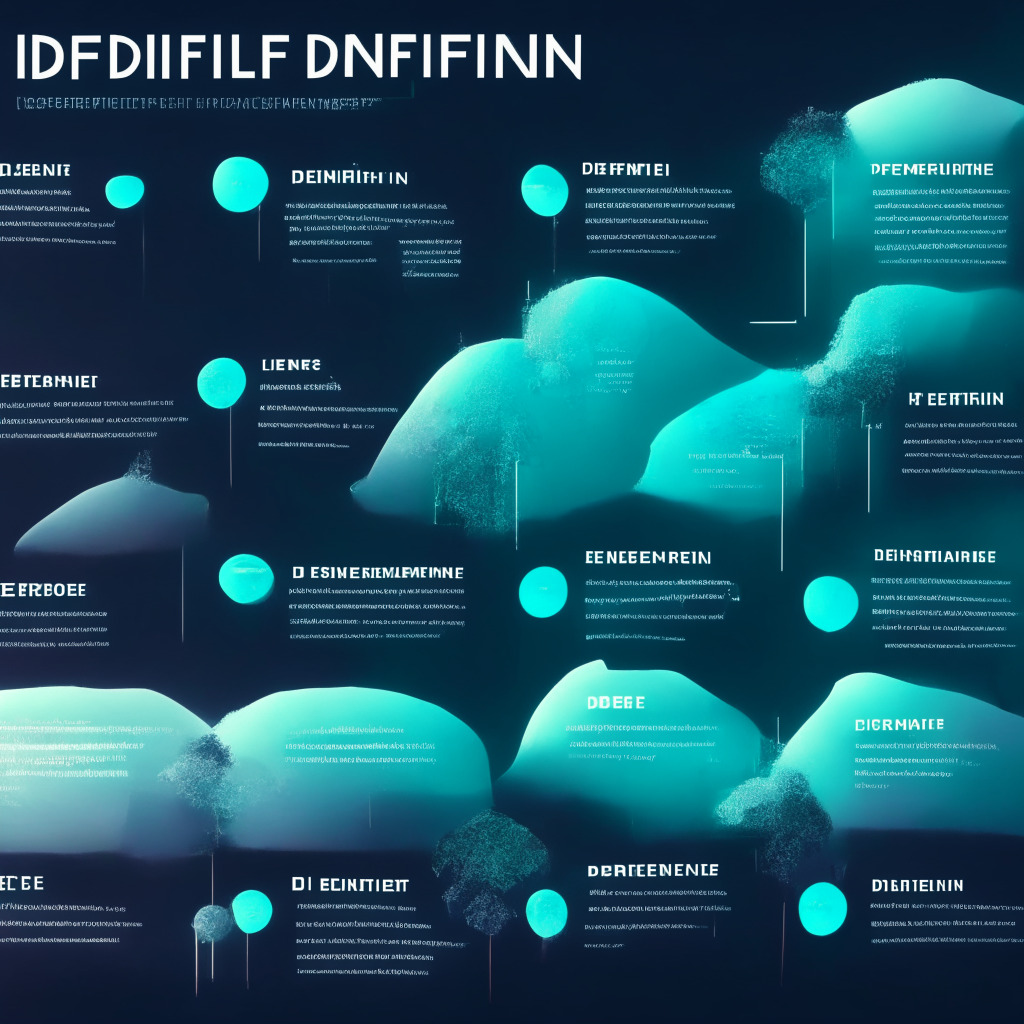“In the crypto world, security is paramount. Recently, lending app Era Lend on zkSync experienced a $3.4 million exploit due to a ‘read-only reentrancy’ bug. This exploit illustrates the need for advanced tools and strategies in bolstering blockchain security, highlighting the importance of extensive audit capabilities to prevent similar vulnerabilities.”
Search Results for: Era Lend
Era Lend on zkSync: Analyzing a $3.4 Million Security Breach’s Impact on the Future of Blockchain
“Era Lend, a lending protocol on the Ethereum scaling blockchain zkSync, experienced a significant security breach via a $3.4 million read-only reentrancy attack. This event led to a nearly 40% drop in its total locked capital, highlighting the ongoing issue of blockchain security vulnerabilities. However, incidents like these also provide essential lessons towards building a more resilient and secure blockchain ecosystem.”
Bankruptcy Recuperation: Celsius Lender’s $2 Billion Asset Sale to Fahrenheit Group and its Implications for Crypto Market
Celsius’s bankruptcy proceedings may see it offloading assets to Fahrenheit Group following approval from a federal judge. The proposed scheme could see creditors receive a substantial $2 billion, with final disbursement expected before year-end, pending court’s decision in October. This restructuring has received support within the cryptocurrency community. The new entity’s speculative estimate is $500 million, with commitments to erect new mining facilities.
DeFi Protocol EraLend Robbed of $3.4M: A Wake-up Call for Blockchain Security
“EraLend, a Decentralized Finance (DeFi) Protocol, has lost $3.4 million in a ‘re-entrancy attack’. This incident underscores the need for advanced security protocols within blockchain transactions, highlighting how dependencies and vulnerabilities can be exploited.”
Exploring the NFT Lending Boom: Blue-Chip Collaterals, Liquidity Concerns & Future Prospects
The NFT lending market has grown to over $430 million, supported by blue-chip collaterals like Wrapped CryptoPunks and Bored Ape Yacht Club. However, liquidity concerns, limited user numbers, and pricing difficulties remain challenges in this developing sector. Innovative solutions, such as NFT fractionalization and staking, aim to address these issues and provide accessible opportunities for all market participants.
Uncollateralized Lending in DeFi: Atlendis Revolutionizes Access and Boosts Liquidity
Atlendis, an uncollateralized lending platform, introduces new features and a crypto on-ramp to revolutionize access to decentralized finance (DeFi) and boost liquidity. Unlike traditional overcollateralized loans, Atlendis streamlines borrowing, partnering with Credora for creditworthiness checks and offering a Know-Your-Customer option for pool compliance.
Blend’s NFT Collateralized Lending Protocol: Boon or Bane for Crypto Enthusiasts?
NFT marketplace Blur introduced its collateralized lending protocol, Blend, enabling a buy-now-pay-later approach for NFTs, using NFT collateral for fee-free lending. The move garnered mixed reactions, with proponents highlighting its potential to enhance efficiency, while critics voiced concerns over the risks associated with NFT lending and its impact on the volatile NFT market.
Blending Art and Blockchain: Dubai’s 37xDubai Explores NFTs and Web3 Future
“Dubai-based art gallery, 37xDubai, aims to educate artists and enthusiasts about Nonfungible Tokens (NFTs) and the Web3 ecosystem. The gallery is blending art and technology, viewing NFTs as a method to foster inclusivity within the art community. However, the unpredictable market conditions add complexity to this innovation.”
Decentralized Lending Protocol Shutdown vs. El Salvador’s Cryptocurrency-Powered Growth: A Tale of Crypto’s Dynamic Landscape
“Yield Protocol, a decentralized lending protocol, plans to cease operations by end of 2023 due to unsustainable business demand and mounting regulatory pressures. Meanwhile, El Salvador launches renewable energy Bitcoin mining operation, Volcano Energy, exemplifying the industry’s dynamic nature.”
Binance Axes BUSD Lending Services: A Setback or Smart Strategy?
“Binance is discontinifying its Binance USD (BUSD) lending services, with a full termination of BUSD support planned for 2024. The decision comes after issuer Paxos severed ties with Binance amid litigation with the U.S. Securities and Exchange Commission. Users are now urged to convert their BUSD to other currencies.”
Navigating NFTs: How Musician Vérité Blends Blockchain Innovation with Fan Loyalty
Independent musician Vérité leverages NFTs and Web3 to build a fan-centric community, fractionate song royalties via blockchain, and add value to concert experiences. However, she emphasizes caution, respectful interaction, and not solely depending on these digital tools due to their inherent risks and potential non-sustainability.
Bankruptcy of Haru Invest: Impacts on Crypto Lending and The Future of Stablecoins
South Korean CeFi firm Haru Invest, recently filed for bankruptcy following fraud allegations. This incident affected fellow crypto lender, Delio, leading to a suspension of deposits and withdrawals in June. Despite bankruptcy, Haru set a phased asset recovery plan aiming to return investments equally to its users.
Microsoft’s Nuclear-AI Venture: A Leverage or a Risk? Unpacking Crypto’s Latest Developments
Microsoft is recruiting a program manager for their nuclear technology initiatives, as part of their plan to harness AI and nuclear energy together. This move, while offering efficient energy consumption, brings up concerns due to its controversial and risky nature.
CEO Deny Puts Spot on Blockchain Future: Crypto-Lending Brings Risk and Reward
Former FTX CEO, Sam Bankman-Fried, has been denied temporary release ahead of his trial, with concerns about him being a flight risk. Meanwhile, BTC lending platform, Ledn, introduces an Ethereum yield product, highlighting the interplay between regulation and innovation in blockchain.
Bridging Artistry and Blockchain: The Rise of Generative Art in the Crypto Sphere
“William Mapan, a noted NFT artist, likens blockchain-based generative art to drawing guided by the roll of dice. A harmonious blend of predetermined rules and randomness, this form of artistry aims to evoke emotions and trigger personal memories in the audience. Despite market fluctuations, the allure of the unique union of blockchain technology and artistic creativity persists.”
The Volatility Conundrum: Genesis Crypto Lending Halts Trading Amid Regulatory Challenges
Genesis, a crypto lending firm, has halted its crypto trading services citing business reasons. This move underlines the volatile nature of the crypto market and the strain it puts on trading platforms. Despite recent issues, the dedication to innovation in turbulent times suggests a promising future for digital currency.
Cryptocurrency’s Bold Advances & Legal Challenges: Analyzing Deutsche Bank, South Korean Bitcoin Lenders, EY.ai & More
“Deutsche Bank collaborates with Taurus, providing custody services for clients’ cryptocurrencies and tokenized assets. Meanwhile, Delio, a South Korean Bitcoin lender, contests fraud and embezzlement allegations, exposing lack of clear virtual asset regulations. Also, Ernst & Young unveils AI platform, and Mauve, a Decentralized Exchange, launches its operations.”
Opera’s New Step into Blockchain: Introducing MiniPay Stablecoin Wallet in Africa
Opera plans to launch a non-custodial stablecoin wallet, MiniPay, in Africa. This wallet, built on the Celo blockchain, allows users to send or receive stablecoins using their mobile numbers. However, concerns about high fees and unreliable service remain. MiniPay will only support Celo Dollar, aimed to prevent user confusion with multiple currencies. Despite the recent downturn in fintech, the blockchain sector maintains resilience in Europe.
Federal Case Against Ex-CEO Mashinsky: Litmus Test for Crypto Regulation and Its Future
“Ex-CEO of lending giant Celsius, Alex Mashinsky, is battling an FTC case against him, arguing the allegations don’t prove fraudulent intent. Key issues involve the Gramm-Leach-Bliley Act requirements and whether Mashinsky, who had resigned, could violate the law. The outcome could set a crypto-lending regulatory precedent.”
Noncustodial Liquidity Markets: Bridging Decentralized Finance with Seamless Lending & Borrowing
A Layer-2 network known as Base introduces noncustodial liquidity markets, changing the traditional ‘trust humans over algorithms’ dynamic. This innovation allows smart contracts to connect liquidity pools with borrowing strategies and promotes transparency. The Seamless Protocol enables streamlined undercollateralized borrowing, minimizing complexity and challenges usually associated with typical DeFi loans.
Navigating Turbulence: Crypto Lending, Slumps, and Bold Moves in Blockchain Landscape
“Crypto giant Coinbase unveils its lending platform targeted to institutional investors amidst turbulent crypto market conditions. Meanwhile, Google’s new ad policy will allow promotion of blockchain-based NFT gaming, hinting at further acceptance of digital assets.”
Bankrupt Crypto Lender’s Struggle to Recover Assets meets New Accounting Rules for Crypto-native Companies
The bankrupt crypto lender, Celsius Network, seeks to recover its properties from EquitiesFirst Holdings, following a failed collateral retrieval. Meanwhile, the Financial Accounting Standards Board approves the fair value of companies’ cryptocurrency holdings starting in 2025, generating mixed industry responses.
Bankrupt Crypto Lender versus Private Lending Platform: A Legal Wars Saga Unravels
“Bankrupt crypto lender, Celsius Network, has launched a complaint against EquitiesFirst Holdings, seeking to reclaim assets. Following claims EquitiesFirst held a $439 million debt backed by Celsius in cash and Bitcoin. This amidst Celsius’s tumultuous saga of collapsing market value, co-founder’s legal charges, and foggy future of asset buyout by potential bidders.”
Dissecting the Perils and Promise of Bitcoin Lending: Enlightenment from the Failures
“Bitcoin lending must innovate a sustainable model independent of government institutions. However, a lack of transparency and risk management resulted in collapsed lending firms. The proposed solution is a two-account system to separate safekeeping assets from lending, ensuring transparency and ‘ring-fencing’ risk.”
Blockchain Boom: Story Protocol’s IP Ownership vs. Coinbase’s Crypto Lending Battle
“Story Protocol is using blockchain technology to empower content creators and oversee their content, countering falsified AI-generated content. Meanwhile, Coinbase has launched an institutional-grade crypto lending platform, Coinbase Prime. These high-value projects symbolize the maturing crypto technology space.”
Coinbase’s Leap into Crypto Lending: Opportunity Packed With Challenges
“Coinbase Prime, an institutional-grade crypto lending service, has been launched by Coinbase, offering prime brokerage services such as digital asset execution and custody. Despite $57 million invested already, challenges lie ahead with regulators and community trust.”
Coinbase’s Institutional Crypto-Lending Service: A Bold Venture or a Risky Gamble?
Coinbase has launched a crypto-lending service targeting its institutional clients in the US. The initiative intends to fill the gap in institutional crypto-lending, and it was announced via an SEC filing. The service uses a Regulation D exemption, letting clients provide primarily crypto assets and receive over-collateralized loans. This new venture raises questions about avoiding regulatory uncertainties and potential financial risks.
Coinbase’s New Crypto Lending Venture: A Strategic Move or Risky Venture?
COIN recently launched a crypto lending venture exclusively for US institutional clients, attempting to fill a gap left by setbacks from Genesis and BlockFi. With $57 million already contributed through Coinbase’s Prime Service, this program allows institutions to lend digital assets under standardized terms for a Regulation D exemption. The loan system sees collateral exceeding loan value in return, aiming to facilitate economic freedom and trust in the crypto world.
Coinbase Steps into Crypto Lending for Institutions: A Brave New Venture or Risky Endeavor?
Coinbase has introduced a new crypto lending service aimed at institutional clients in the U.S, in a move to replace fallen players such as Genesis and BlockFi. The service allows clients to lend money in crypto assets with more collateral than the loan amount, adjusted daily. This initiative has already raised over $57 million. Unlike similarly failed services, the focus here is strictly on institutions, which provides a safety net against previous issues. However, critics express concerns about its potential to expose institutions to extra risks due to crypto volatility.
Insufficiency Claims Surround Genesis’ Bankruptcy Settlement: A Muddled Affair in Crypto Lending
“The proposed settlement agreement on the bankruptcy of cryptocurrency lender, Genesis, has met resistance. Some lenders argue that the agreement, offering 70%-90% recoveries, neglects fiduciary duties to maximize creditor recoveries. Concerns also emerge about non-consensual third-party releases, wherein non-debtor parties are absolved from liability without consensus from all potential claimholders.”
Bitcoin Spot ETF Reconsideration: A Cause for Optimism or Premature Euphoria?
The U.S. Security and Exchange Commission’s reconsideration of Grayscale’s Bitcoin spot ETF has sparked optimism among market participants. Despite this, some remain cautious, warning that the decision doesn’t guarantee Grayscale an ETF listing. Further, the stagnation of digitized asset markets and potential negative effects of bitcoins held at short-term loss could impact faith in Bitcoin. However, the decision suggests possible future favorable decisions on regulatory reforms in the U.S. digital asset markets.
Bridging the Gap: BOB Solution Blends Bitcoin and Ethereum Amid Controversy
“Interlay recently unveiled its Minimum Viable Product (MVP), the Build on Bitcoin (BOB) solution, designed to link Ethereum blockchain advancements with Bitcoin’s user community. BOB will enable decentralized application development, leveraging Rust smart contracts compatible with Bitcoin legacy libraries, while also supporting Ethereum Virtual Machine. Despite concerns from some Bitcoin advocates, the Interlay team remains optimistic about broadening Bitcoin’s applicability.”































